- A stupa (literally “heap” or “pile”) is a reliquary, a shrine containing the remains of a holy or sainted person and/or artifacts (relics) associated with them, originating in India prior to the 5th century BCE as tombs of holy men and evolving afterwards into sacred sites dedicated to the Buddha (l. c. 563 – c. 483 BCE).
- Later, stupas were also raised to honor Buddhist arhats (saints), bodhisattvas (enlightened ones), other saintly figures, or local deities. A stupa is a hemispherical structure, with a spire at the top, sometimes situated on a base that varies in shape and size (depending on the designated purpose of that particular stupa) surrounded by a walkway for visitors.
- Buddhism was the earliest Indian religion to require large communal spaces for worship.
- This led to three types of architectural forms the stupa, the vihara and the chaitya.
- Many religious Buddhist shrines came up between the 1st century BC – 1st century AD.
- The term stupa has been referred to in Rig Veda but not in the context as we know it. The term then referred to the fire coming out of the sacrificial altar.
- Rigveda refers to a Stupa raised by the King Varuna above the forest in a place having no foundation.
- Pali word “Thupa” means a conical heap, a pile or a mound or a conical or bell shaped shrine containing arelic.
- Stupa, originally the focus of a popular cult of the dead, is a large burial mound containing a relic of the Buddha.
- It celebrates the Buddha’s parinirvana (end of cycle of suffering), symbolizes his eternal body, and is an object of worship.
- There is evidence of community patronage of landowners, merchants, officials, monks, nuns and artisans associated with these Buddhist projects.
- Initially stupas were Buddha’s relic places. Then it got extended to his followers as well and gradually stupa itself became an object of worship.
- Some stupas, such as the Great Stupa at Sanchi, India, or the Boudhanath Stupa at Kathmandu, Nepal, are large, ornate structures while others are more modest.
- The construction of stupas, on a large scale and associated with Buddhism, began throughout India during the reign of Ashoka the Great (268-232 BCE) of the Mauryan Empire (322-185 BCE) after his conversion to Buddhism.
- Prior to Ashoka’s reign, there were eight stupas (or ten, according to some scholars) dedicated to the Buddha (and containing his cremated remains) at different sites, which correlated to important events in his life. In an effort to spread Buddhism and encourage the enlightenment of his subjects, Ashoka had the remains disinterred and ordered the construction of many more (84,000, according to legend), each one receiving a certain allotment of the remains which empowered the structure with mystical energy.
- Buddhist stupas are only one type, as there are also Hindu and Jain stupas, but Buddhist stupas remain the most popular, and their construction, worldwide, has been the most prolific.
- Stupas exist in countries around the world, from India to Sri Lanka, Nepal, China, European nations, Australia, the United States, and more. Whichever culture raises one of these structures, its purpose is always the same: to provide a sacred space for people to center themselves on higher thoughts and revitalize themselves spiritually.
- After the demise of Buddha and his cremation at Kushinagar and later the corporeal relics was distributed among 8 Mahajanapadas.
- Initially 8 Stupas (Saririka Chaityas) were constructed at 8 centres ➔ Rajagrihya, Vaishali, Kapilavastu, Allakappa, Ramagrama, Vethadipa, Pava and Kushinagara.
- Drona the Brahmin who initiated the distribution, himself erected a Stupa to enshrine the urn that was used to divide the relics.
- Mauryas arrived too late for a share of the relic and were given the wood ashes from the cremation pyre, and they too built a Stupa in their city of Pipphalavana.
- Thus all together 10 Stupas were erected i.e. 8 on corporeal relics and two on urn and over wood ashes by Drona and the Mauryas respectively.
- Stupa is the built on the relics of buddha like his bodily remains and objects used by him.
- They were built by the donations of king specially of Satavahanas; guilds such as ivory workers; men and women, bhikkhus and bhikkhunis.
- Jatakas mentions about the existence of Stupa but does not throw any light on the structural details of Stupa.
- Sujata Jataka and Bahiya Sutta describes Stupas as raised earthen mounds to commemorate the deceased ➔ This indicates that most probably prior to Ashoka most of the stupas were made of clay.
- Archaeological excavations and findings proved that during Ashoka’s reign use of bricks and stone for constructional purpose became popular. Predecessors of Ashoka like Bimbisara and Ajatsatru both had constructed a number of Stupas in honour of the Buddha which contained relics of Buddha.
- With the emergence of Mahayana sect it was not necessary that all the Stupas contained relics. It was taken over by the image worship, with the transformation from non-iconic to iconic for changes were also found in the architectural patterns.
- After Ashoka none of the Mauryan ruler showed any interest in propagating Buddhism. Then the Sungas gave a new dimension to the Stupa architecture. During Sunga and Ikshvakus period enlargement and additions were made in the existing Stupas of Sanchi, Bharhut and Amravati.
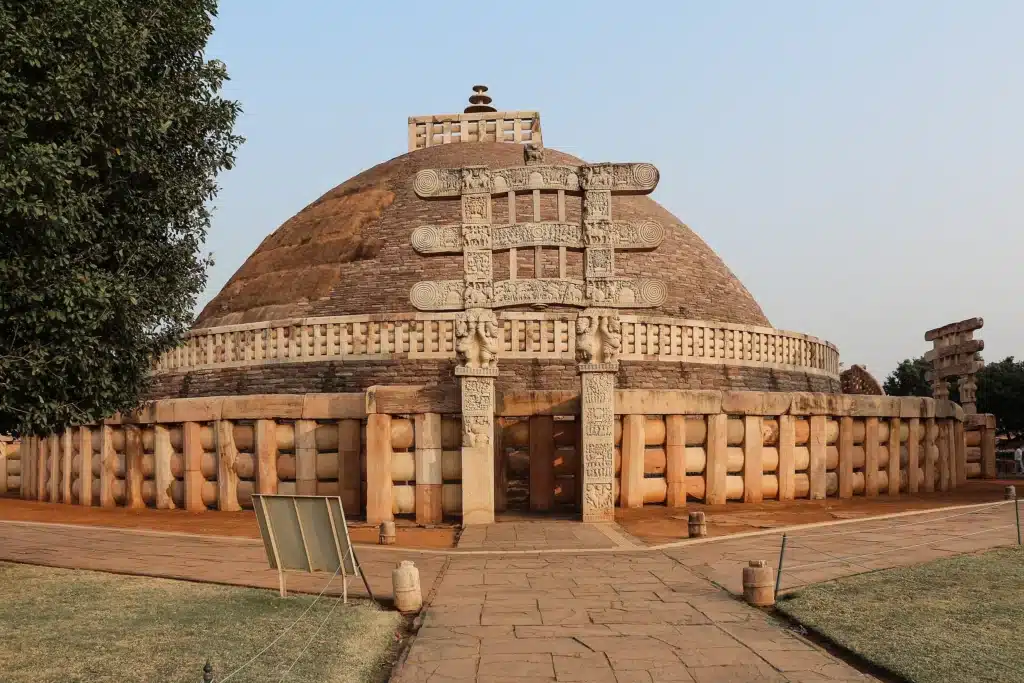
Meaning, Function & Structure of Stupa
- The fundamental basis of Buddhism is that life is suffering: one suffers for want of what one does not have but, once one has that thing, suffers for fear of losing it and, once it is gone, suffers the loss.
- As long as one lives, one will suffer in this way but, the Buddha realized, there was a way to stop suffering, and this was to change the way one interpreted the world and one’s self. Through an understanding of the Four Noble Truths, and practicing the precepts of the Eight-Fold Path, one could elevate one’s understanding of existence, control one’s thoughts and actions, and live at peace with one’s self and others.
- All that one desires, fears losing, and mourns for are ephemeral – they were not made to last – and so are without final meaning; one should, therefore, appreciate these aspects of life for what they are but not cling to them since it is their nature to appear for only a short time and then vanish. The Buddhist stupa is a physical manifestation of this understanding which invites adherents to both center and elevate themselves through various rituals or simply by gathering and focusing their energies at the site.
- The physical appearance of the stupa is intended to elevate the mind. The top spire (yasti) symbolizes the axis mundi (axis of the world), the line through the center of the earth which the universe revolves around. It is also thought to represent the World Tree whose roots are deep within the earth and branches in heaven, a symbol common in many cultures around the world. The yasti is surrounded by a square gate known as the harmika, and over the yasti and harmika are parasols which symbolize protection, majesty, and the Buddha himself.
- The large hemisphere descends from the yasti to a platform or base, sometimes square, which is often surrounded by a wall with four gates (toranas) corresponding to the four cardinal directions. These directions, in turn, relate to four events in Buddha’s life:
- East – Birth of Buddha
- South – Enlightenment of Buddha
- West – First Sermon of Buddha
- North – Nirvana/Release from Samsara of Buddha

Basic structure of Stupa
- The stupa consists of a square platform knows as medhi.
- On medhi there is a hemispherical structure which encloses a casket.
- The medhi is surrounded by vedika(boundary wall).
- Between the medhi and the vedika was pradakshina path or the circum-ambulatory.
- On the stupa there was harmika followed by one or more chatris which signified ‘axis mundi’ or axis of the world.

Features of Stupa
- The stupa’s core was composed of unburnt brick, with a burnt brick outer face covered in a thick coating of plaster.
- The stupa was capped by a wooden railing that encircled a pradakshina walkway (circumambulatory path).
- It is a magnificent stupa with a circumambulatory route and a circular mound. During the time of Ashoka, the big stupa at Sanchi was erected with bricks, then covered with stone and many further additions were made.
- Gateways were added in addition to the circumambulatory circuit. With the elaborations in stupa design, architects and sculptors had plenty of room to plan elaborations and carve out images.
- Wooden sculptures were used to embellish the medhi and toran. As a form of worship, devotees walk around the pradakshina patha, or open ambulatory pathway.
- Sculptures were largely utilized to decorate stupas, the torana, and the medhi, as well as a form of religious expression.
- The three chhatra on the stupas symbolize the Buddhist triratnas: Buddha (the enlightened), Dhamma (doctrine), and Sangh (community).
- Bairat in Rajasthan has one of the outstanding examples of a stupa building from the third century BCE.
- Sanchi Stupa in Madhya Pradesh, for example, is the most well-known Ashokan stupa. The oldest is the Piprahwa stupa in Uttar Pradesh.
- Rajagriha, Vaishali, Kapilavastu, Allakappa, Ramagrama, Vethapida, Pava, Kushinagar, and Pippalivana are the nine stupas built following Buddha’s death.
Structure of Stupa – terminology
- Anda
- It is the semi-circular mound built on earth.
- Harmika
- It is the balcony like structure above anda.
- It is believed to be the living place of god.
- Yashti
- It is the mast above harmika surmounted by umbrella.
- Railing
- It is around the mound believed to separate the stupa from surrounding world and make it sacred.
- Chatra
- It is the umbrella built on the top of the dome
- Pradakshinapatha
- It is the path for clockwise circumambulation surrounded by a fence built encircling the stupa.
- Stone balustrade (wooden fence) consisted of thabas (octagonal upright posts) capped by uhnisa (continuous caping stone).
- These posts are connected by 3 horizontal rails called Suchis.
- Torana
- Gateways having sculptures depicting Jataka Tales
- Medhi
- Square platform
- Aniconist buddha
- It is related with Hinayana or Theraveda Buddhism.
- It prohibits representing Buddha in human form.
- Instead they use symbol ➔ Example Empty seat to indicate meditation of Buddha; wheel represent Dharmachakra and first sermon of Buddha in sarnath, stupa indicate mahaparinirbana of buddha.
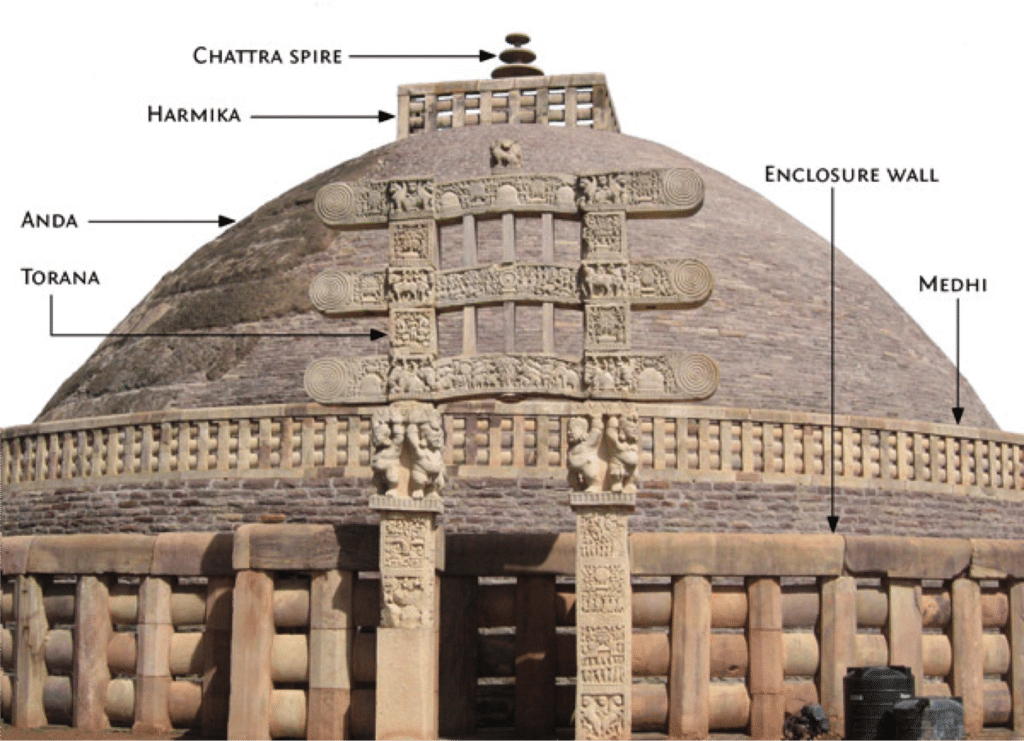
Stupa Architecture in North India
- There is very little information regarding the history of the development of Stupa architecture in north.
- The Gupta period is considered as the golden age of Indian history.
- Guptas were Vaishnavites but were tolerant towards Buddhism.
- It is said that the Stupa at Sarnath was built during the Gupta period.
Stupa Architecture in South India
- The architectural movement in the south (Andhra) flourished under Satavahanas.
- Rock cut architecture of Hinayana sect became more prominent.
| Northern India | Southern India |
|---|---|
| Presence of torana dwara | No torana dwara |
| Circular stupa | Non circular stupa |
| No decorations on hemispheres | Decorations present on hemisphere |
| Buddha depicted by symbols | Buddha depicted by symbols as well as in anthropomorphic forms |
Different kinds of Stupas
- Sharirik – the casket enclosed the mortal remains of various Buddhist figures such as the sariputra and
maudgalayan stupa at sanchi. - Paribhogika – the casket enclosed the various objects and utensils used by the various Buddhist figures during their lifetime.
- Uddeshika –mainly used for pooja and aradhana
Classification of Stupas based on form and function
- Relic Stupa–in which the relics or remains of the Buddha, his disciples and lay saints are interred.
- Object stupa – in which the items interred are objects belonged to the Buddha or his disciples such as a begging bowl or robe, or important Buddhist scriptures.
- Commemorative stupas – built to commemorate events in the lives of Buddha or his disciples.
- Symbolic stupa – to symbolise aspects of Buddhist theology, for example, Borobuddur is considered to be the symbol of “Three Worlds (dhatu) and the spiritual stages (bhumi) in a Mahayana bodhisattva’s character.”
- Votive stupas – constructed to commemorate visits or to gain spiritual benefits, usually at the site of prominent stupas which are regularly visited.
Stupa Architecture in different periods
- The shape of the stupa represents the Buddha, crowned and sitting in meditation posture on a lion throne.
- His crown is the top of the spire; his head is the square at the spire’s base; his body is the vase shape; his legs are the four steps of the lower terrace; and the base is his throne.
- The stupa represents the five purified elements
- 1. The square base represents earth
- 2. The hemispherical dome/vase represents water
- 3. The conical spire represents fire
- 4. The upper lotus parasol and the crescent moon represents air
- 5. The sun and the dissolving point represents the element of space
- The core of the stupa was made up of unburnt brick and the outer face of burnt brick, covered with thick layer of plaster.
- The stupa was crowned by an umbrella of wooden fence enclosing a path for pradaskshina (circumambulatory path).
- One of the best examples of the structure of a stupa in the 3rdcentury BC is at Bairat in Rajasthan. It is a very grand stupa having a circular mound with a circumambulatory path.
- The great stupa at Sanchi was built with bricks during the time of Ashoka and later it was covered with stone and many new additions were made.
- Ashoka was responsible for the construction of several stupas, which were large halls, capped with domes and bore symbols of the Buddha.
- The most important ones are located at Bharhut, Bodhgaya, Sanchi, Amravati and Nagarjunakonda.
- In the subsequent century, stupas were elaborately built with certain additions like the enclosing of the circumambulatory path with railings and sculptural decoration.
- There were numerous stupas constructed earlier but expansions or new additions were made in the 2nd century BC.
- The stupa consists of a cylindrical drum and a circular and a with a harmika and chhatra on the top which remain consistent throughout with minor variations and changes in shape and size.
- The three chhatra on the stupas represent triratnas of Buddhism i.e. Buddha (The enlightened), Dhamma (doctrine) and Sangh (order).
- Apart from the circumambulatory path, gateways were added.
- Thus, with the elaborations in stupa architecture, there was ample space for the architects and sculptors to plan elaborations and to carve out images.
- During the early phase of Buddhism, Buddha is depicted symbolically through footprints, stupas, lotus throne, chakra, etc.
- This indicates either simple worship, or paying respect, or at times depicts historicization of life events.
- Gradually narrative became a part of the Buddhisttradition.
- Thus events from the life of the Buddha, the Jataka stories, were depicted on the railings and toranas of the stupas.
- Mainly synoptic narrative, continuous narrative and episodic narrative are used in the pictorial tradition.
- While events from the life of the Buddha became an important theme in all the Buddhist monuments, the Jataka stories also became equally important for sculptural decorations.
- The main events associated with the Buddha’s life which were frequently depicted were events related to the birth, renunciation, enlightenment, dhammachakrapravartana, and mahaparinibbana (death).
- Among the Jataka stories that are frequently depicted are Chhadanta Jataka, Vidurpundita Jataka, Ruru Jataka, Sibi Jataka, Vessantara Jataka and Shama Jataka.
- The original brick Stupa built during Ashoka’s time was at first enclosed by wooden fence and later replaced by the massive stone balustrade.
- All the four gateways were in beautiful sculptures.
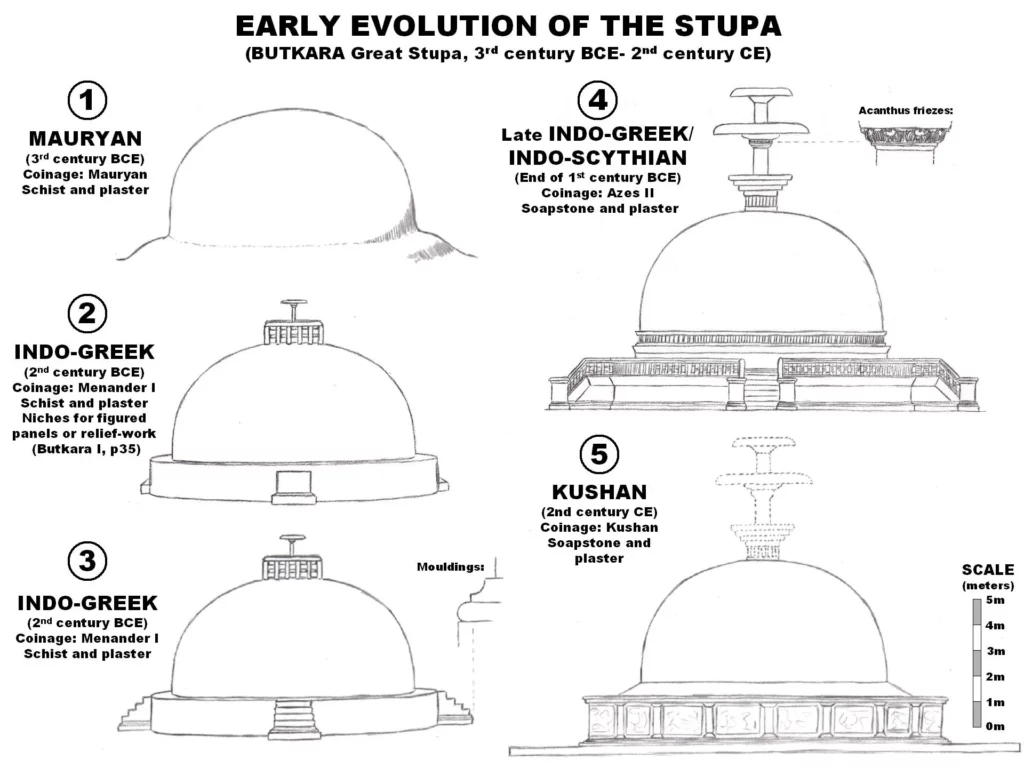
Piprahwa Stupa (Uttar Pradesh)
- Piprahwa is a village near Siddharthnagar city in Siddharthnagar district of the Uttar Pradesh.
- Piprahwa is best known for its archaeological site and excavations that suggest that it may have been the burial place of the portion of the Buddha’s ashes that were given to his own Shakya clan.
- A large stupa and the ruins of several monasteries as well as a museum are located within the site. Ancient residential complexes and shrines were uncovered at the adjacent mound of Ganwaria.
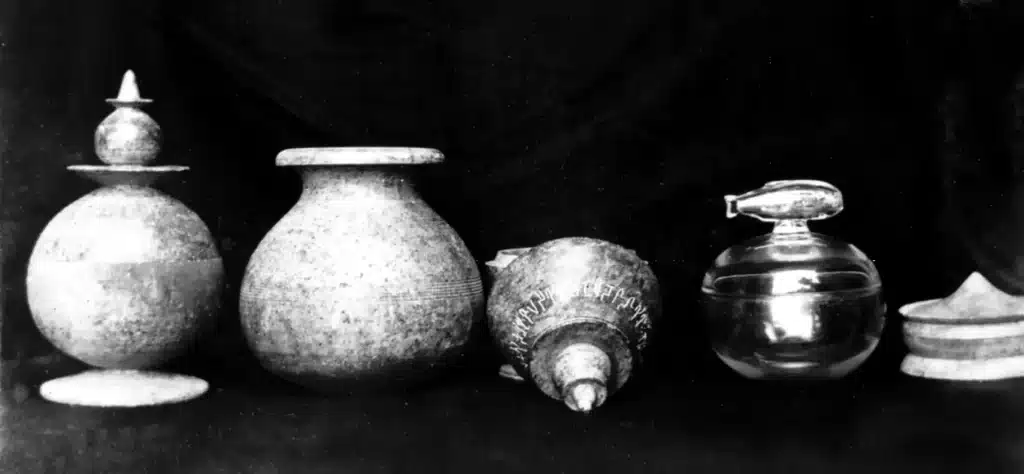
Ramabhar Stupa (Kushinagar, UP)
- Ramabhar Stupa was built over a portion of the Buddha’s ashes on the spot where he was cremated by the ancient Malla people.
- Ramabhar Stupa, also called a Mukutbandhan-Chaitya, is the cremation place of Buddha. This site is 1.5 km east of the main Nirvana Temple on the Kushinagar-Deoria road.
- dome shaped monument having brickworks and stands at a height of 49 feet
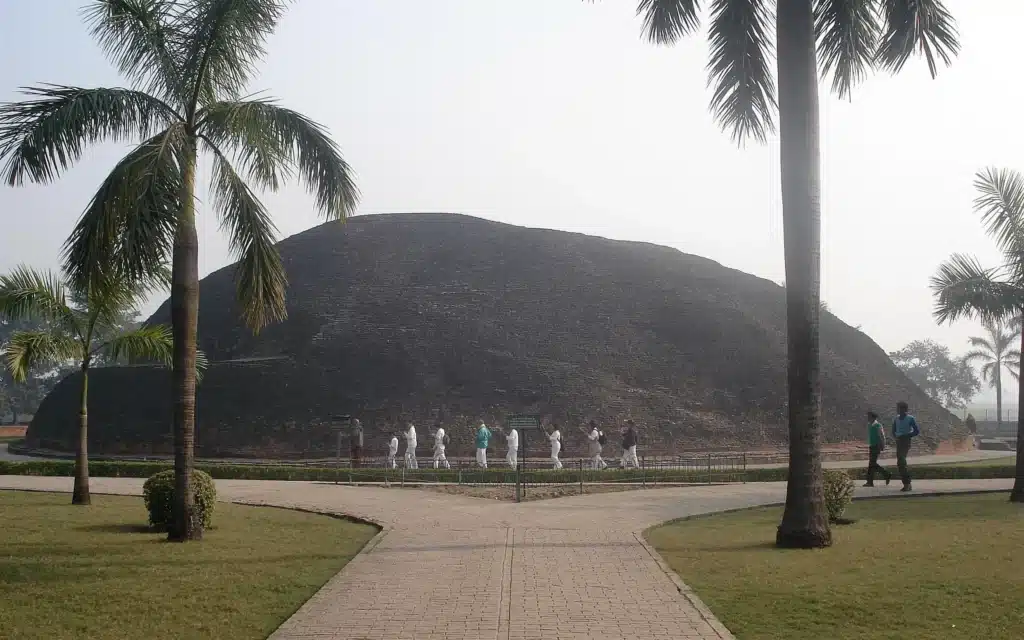
First Relic (Saririka) Stupas at Vaishali
- Buddha Relic Stupa, enshrining one of the eight parts of the mortal remains of Lord Buddha after he attained Mahaparinirvana, is one of the most revered sites for Buddhists and a protected one for Archaeological Survey of India (ASI), located around 55km northwest of Patna in Vaishali district.
- The Buddha Relic Stupa was built by Lichhavis as a mud-stupa in the 5th century BC.
- Asoka→ opened the stupa to take out a little of the relic and thereafter closed the monument while keeping back the original casket and coated the stupa with bricks.
- The stupa was later discovered in an archaeological excavation carried out under the aegis of Patna-based K.P. Jayaswal Research Institute during 1958-1962.
- The relic casket excavated from the core of the stupa contained the holy ashes of Lord Buddha mixed with earth, a piece of conch, pieces of beads, a thin golden leaf and a copper punch-marked coin.
- The casket was brought to Patna Museum in 1972.
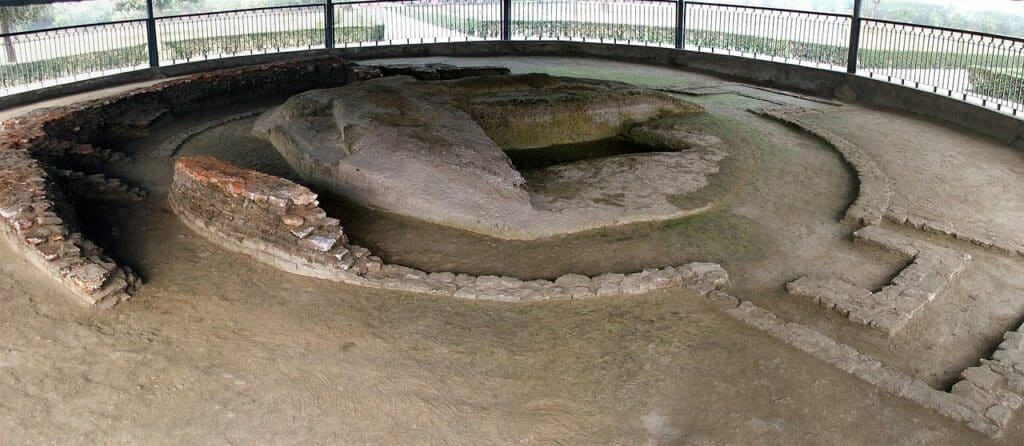
Kesariya Stupa (Bihar)
- Kesariya stupa is a Buddhist stupa in Kesariya, located at a distance of 110 kilometres (68 mi) from Patna, in the Champaran (east) district of Bihar.
- The stupa is said to be the tallest and the largest Buddhist stupa in the world.
- Kesariya Stupa has a circumference of almost 400 feet (120 m) and raises to a height of about 104 feet (32 m).
- The ASI (Archaeological Survey of India) has declared it a protected monument of national importance.
- History:
- The first construction of the Stupa is dated to the 3rd century BCE. The original Kesaria stupa probably dates to the time of Ashoka (circa 250 BCE), as the remains of a capital of a Pillar of Ashoka were discovered there.
- The current stupa dates to the Gupta Dynasty between 200 AD and 750 AD and may have been associated with the 4th century ruler Raja Chakravarti.
- The stupa mound may even have been inaugurated during the Buddha’s time, as it corresponds in many respects to the description of the stupa erected by the Licchavis of Vaishali to house the alms bowl the Buddha has given them.
- In ancient times, Kesaria was under the rule of the Mauryas and the Licchavis.
- Two great foreign travelers, Faxian (Fahien) and Xuan Zang (Hsuan Tsang), had visited this place in ancient times and have left interesting and informative accounts of their travels.
- The discovery of gold coins bearing the seal of the famous emperor Kanishka of the Kushan dynasty (AD 30 to AD 375) goes on to further establish the ancient heritage of Kesaria.
- Exploration:
- The stupa’s exploration had started in the early 19th century after its discovery led by Colonel Mackenzie in 1814.
- Later, it was excavated by General Cunningham in 1861-62 and in 1998 an ASI team led by archaeologist K.K. Muhammad had excavated the site properly.
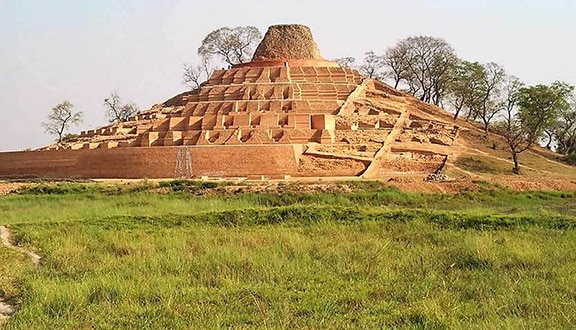
Bairat Stupa
- Bairat Temple is a freestanding Buddhist temple, a Chaityagriha, located about a mile southwest of the city Viratnagar, Rajasthan, India, on a hill locally called “Bijak-ki-Pahari” (“Hill of the Inscription”).
- The temple is of a circular type, formed of a central stupa surrounded by a circular colonnade and an enclosing wall.
- It was built during the time of Ashoka in the 3rd century BCE, and near it were found two of Ashoka’s Minor Rock Edicts, the Bairat and the Calcutta-Bairat Minor Rock Edicts.
- Bairat’s history goes back to the time of the Mahabharata, when it was known as “Viratnagar”. Viratnagar was the capital of the ancient Mahajanapada (kingdom) of Machcha or Matsya.
- The Banganga River originates from a nearby village, Mair.
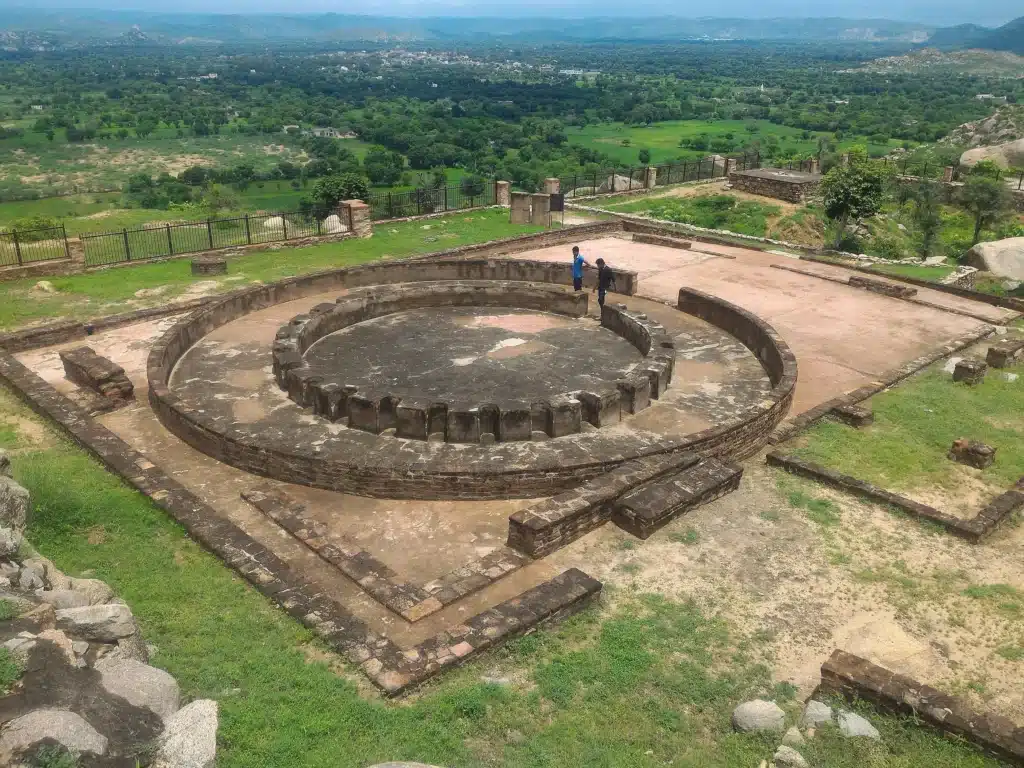
Sanchi Stupa
- Sanchi is a Buddhist complex, famous for its Great Stupa, on a hilltop at Sanchi Town in Raisen District of the State of Madhya Pradesh.
- Early Indian sculpture that adorned the 1st-century BC entrances of the Buddhist relic mound known as the Great Stupa at Sanchi, Madhya Pradesh, which is considered one of the most spectacular monuments of its time. From the 3rd century BC to the 11th century AD, the territory of Sanchi, like the great centers of Sarnath and Mathura, had a continuous artistic history.
- The Sanchi Stupa is one of India’s most important Buddhist landmarks, and it houses some of the country’s earliest stone buildings. Also, It is an important monument of Indian architecture and one of India’s oldest stone constructions.
- It was commissioned in the third century BCE by Mauryan ruler Ashoka the Great. It began with a basic hemispheric brick edifice erected over the Buddha’s relics. Originally, it was smaller than its present dimensions. It was expanded in later periods.
- Sanchi, a historical city nestled in the Vindhya Range 46 kilometers from Madhya Pradesh’s capital Bhopal, also has 50 additional sites, including temples and monasteries.
- The beautiful carvings and inscriptions show Indian architecture from the Mauryan era (3rd century BCE) through its downfall in the later medieval age (around 11th century CE).
- The Mahastupa (Great Stupa), the Ashokan pillar (with its inscriptions), and the beautiful torans are all noteworthy features of the Sanchi complex (gateways).
- Since 1989, Sanchi Stupa has been a UNESCO World Heritage Site. Madhya Pradesh is home to Sanchi.
- It is possibly India’s best-preserved Buddhist monument complex.
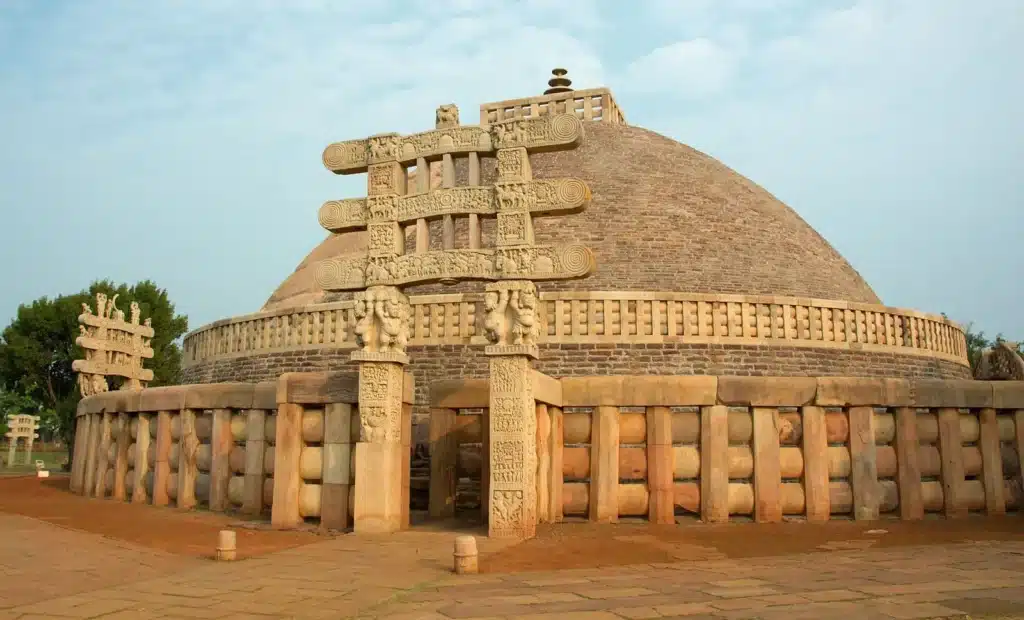
Historical background
- Sanchi’s monuments currently consist of a collection of Buddhist monuments that date from the Mauryan Empire (3rd century BCE), continue through the Gupta Empire (5th century CE), and conclude around the 12th century CE.
- The Great Stupa, also known as Stupa No. 1, is the oldest and greatest monument.
- It was created under the Mauryans and is ornamented with one of Ashoka’s Pillars.
- The Great Stupa was enlarged and ornamented with gates and railings in the succeeding centuries, particularly during the Shungas and Satavahanas, and minor stupas, including Stupa No.2 and Stupa No.3, were also built in the vicinity.
- Stupa-1 is presumed to have the relics of the Buddha,
- Stupa-2, the relics of ten less famous arhats belonging to three different generations. Their names are found on the relic casket.
- Stupa-3 has the relics of Sariputta and Mahamougalayana.
- According to Ashokavadana, the stupa was vandalized sometime during the 2nd century BCE, an incident that some have linked to the ascension of the Shunga monarch Pushyamitra Shunga, who overthrew the Mauryan Empire as an army officer.
- The first stupa may have been demolished by Pushyamitra, and his son Agnimitra rebuilt it, according to legend.
- During the Shunga period, the original brick stupa was covered with stone.
- In 1819, British captain Edward Fell wrote one of the first accounts of the Sanchi Stupa.
- It took another 93 years for John Marshall to ‘rediscover’ the site, and another seven years for it to be restored to its current state.
Sanchi Stupa – Features
- The Mahastupa (Great Stupa), the Ashokan pillar (with its inscriptions), and the beautiful torans are all noteworthy features of the Sanchi complex (gateways).
- The torans and fencing are reported to be modeled after the bamboo crafts of the surrounding areas.
- The design of the stupa’s fencing, as well as the torans’ design, are reminiscent of bamboo craft and knotted bamboo.
- Bricks were used to construct the original construction. It was afterward covered with stone, vedica, and torana (gateway).
- The stupa has four entrances, with the southern one being the first to be completed. Others were added subsequently.
- The gateways are ornately carved and ornamented with statues. Two vertical pillars and three horizontal bars make up each torana. On the front and back of the bars are magnificent sculptures.
- They feature depictions of shalabhanjika, or women grasping a tree branch.
- Here are carved stories from the Jataka tales.
- A lower and upper pradakshina patha, or circumambulatory walk, runs around the structure. This stupa’s upper pradakshina patha is unusual.
- The Ashokan Lion Capital pillar, which has inscriptions on it, may be seen on the southern side of the stupa.
- Buddha is shown symbolically as an empty throne, feet, chhatra, stupas, etc.
- The Anda refers to the stupa’s hemispheric dome. It is where the Buddha’s relics are kept.
- On top of the dome/mound lies the harmika, which is a square railing.
- On top of the harmika, the chhatra is an umbrella. The location contains a sandstone pillar inscribed with Ashoka’s Schism Edict.
- During the rule of the Shunga dynasty, the original brick dome was doubled in size, with stone slabs covering the previous dome.
Connection with Buddhism
- Surprisingly, Buddha never came to Sanchi.
- Foreign travelers like Hiuen Tsang, who documented the famous Buddhist circuit in India but didn’t mention Sanchi in his books, didn’t know either.
- Sanchi was not as revered as other Buddhist pilgrimage sites in India, according to Marshall’s The Monuments of Sanchi (1938).
- The iconic images of Buddha (like the Bodhi tree, a riderless horse, an empty throne, etc.) at Sanchi, according to scholars like Alfred A Foucher, are the result of Graeco-Buddhist architectural interaction.
Bharhut stupa
- Bharhut stupas are tall, like the Mauryan depictions of Yaksha and Yakshini, and the sculptural volume is modeled in low relief to ensure linearity. A large stupa was built in 100 B.C. in Bharhut, which is now part of modern-day Madhya Prade in Satna District).
- The Bharhut stupa may have been established by the Maurya king Ashoka in the 3rd century BCE, but many works of art were added during the Sunga period, with many friezes from the 2nd century BC.
- This stupa is primarily important for its sculpture as the dome is now vanished.
- Bharhut sculptures are tall, like the Mauryan depictions of Yaksha and Yakshini, and the sculptural volume is modelled in low relief to ensure linearity.
- The illusion of three-dimensionality is conveyed with slanted perspective in the relief panels displaying storytelling. The narrative’s clarity is improved by focusing on key occurrences.
- Its railings are made of red stone.
- Gateways, pillars and the uprights and crossbars, all are full of sculptures depicting pictorial representations of nature.
- These sculptures portray some realistic scenes of daily life.
- The stupa (now dismantled and reassembled at Kolkata Museum) contains numerous birth stories of the Buddha’s previous lives, or Jataka tales.
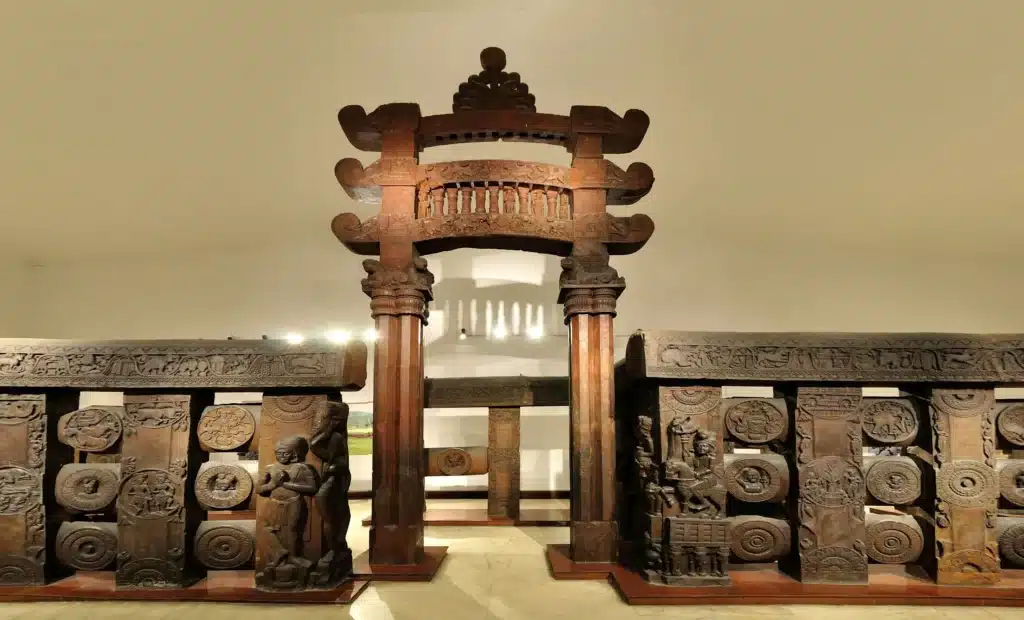
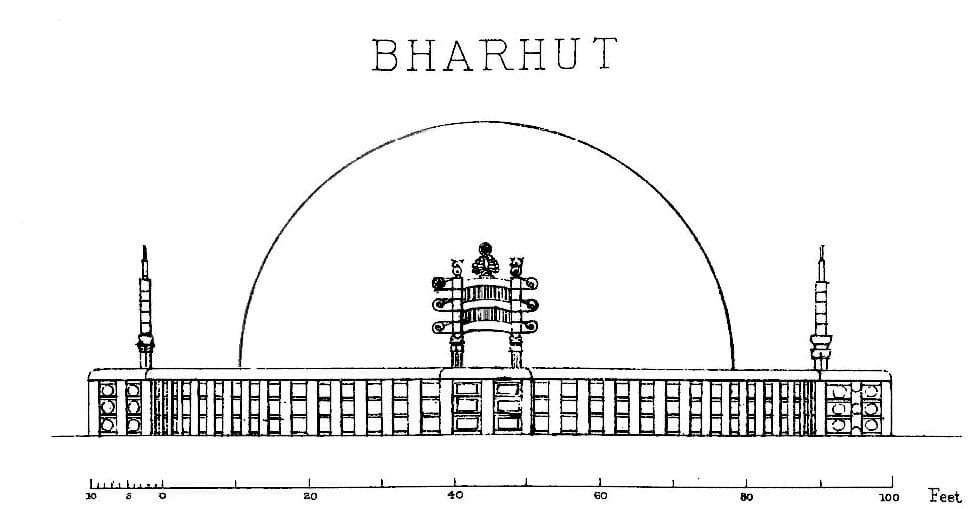
Architectural Significance
- Unlike the Mauryas’ imperial art, the reliefs and figures in Bharhut stupa were provided by lay people, monks, and nuns, according to inscriptions on the railings. As a result, it is considered one of the earliest instances of Maurya popular art.
- The Buddha’s previous incarnations’ birth stories, known as Jataka tales, are depicted on the railings.
- The aniconic phase of Buddhist art is represented by the Bharhut stupa. Buddha has been shown as a series of symbols.
- Except for one foreigner, presumed to be an Indo-Greek soldier, who is represented wearing the Indian dhoti with Buddhist iconography, the style is mainly flat, with low bass relief, and all figures are depicted wearing the Indian dhoti.
- The Bharhut stupa railings feature several depictions of yakshas and yakshis, who have long been a part of Indian society.
- The earliest depictions of the Yakshas and Yakshis, which later became part of later art, may be seen at Bharhut. These represent the spirit of nature and help to remind us of the divinity that lurks beneath all we see.
- The Yakshas and Yakshis represent nature’s protection and plenty, which ensures the continuation of life.
- Kubera, whom the Yaksha and Yakshis attend, is depicted on the north gateway of the Vedika at Bharhut.
- The photos of Yakhsi Chandra and Krishika, who are seen entangled with a tree, can be found. Another Yakshi, Ashok Dohada, holds an Ashoka Tree leaf in her palm as well as a kid in her womb (two hearts) and weaves her way through the tree like a creeper, symbolizing fertility.
- One of the sculptures depicts Laksmi on the Bharhut’s railing, which is the earliest representation of the goddess.
- The sculptures on the Bharhut railings are in low relief and do not have the depth of later Indic art.
- A Greek warrior is depicted on a pillar of the vedika. He has short hair and a headband and is dressed in boots and a tunic.
- A Nagaraja, the serpent king, is shown on another fence, dressed in human form but wearing a serpent hood. Naga deities, like yakshas and yakshis, serve to remind us of the power, protection, and fertility of nature.
- The railing of the Bharhut “stupa” depicts Queen Maya’s dream, which occurred before the Buddha’s birth.
- The figure of the Buddha was never depicted in early Buddhist art. Instead, symbols of him were there, including a seat, footprints, the Bodhi tree, the wheel, and the “stupa.” The railings’ sculptural reliefs are a veritable collection of early Buddhist iconographic elements.
- Narrative reliefs at Bharhut show how artisans used the pictorial language very effectively to communicate stories.
- In one such narrative, showing Queen Mayadevi’s (mother of Siddhartha Gautam) dream, a descending elephant is shown.
- The queen is shown reclining on the bed whereas an elephant is shown on the top heading towards the womb of Queen Mayadevi.
Dhamek Stupa (Sarnath)
- Dhamek Stupa (also spelled Dhamekh and Dhamekha, traced to Sanskrit version Dharmarajika Stupa, which can be translated as the Stupa of the reign of Dharma) is a massive stupa located at Sarnath, 13 kilometres (8.1 mi) away from Varanasi in the state of Uttar Pradesh, India.
- An Ashoka pillar with an edict engraved on it stands near the site.
- It was built in 500 CE to replace an earlier structure commissioned by Ashoka in 249 BCE, along with several other monuments, to commemorate the Buddha’s activities in this location.
- While visiting Sarnath in 640 CE, Xuanzang recorded that the colony had over 1,500 priests and the main stupa was nearly 300 feet (91 m) high.
- In its current shape, the stupa is a solid cylinder of bricks and stone reaching a height of 43.6 meters and having a diameter of 28 meters.
- The basement seems to have survived from Ashoka’s structure: the stone facing is chiseled and displays delicate floral carvings of Gupta origin.
- The wall is covered with exquisitely carved figures of humans and birds, as well as inscriptions in the Brāhmī script.
Importance of Sarnath
- The Dhamek Stupa is said to mark the spot Rishipattana, where Buddha gave the first sermon to his first five Brahmin disciples after attaining enlightenment, “revealing his Eightfold Path leading to nirvana”.
- In several of the ancient sources the site of the first sermon is mentioned to have been at a ″Mriga-dayaa-vanam″ or a sanctuary for animals.
Stories associated with Sarnath
- From Bodh Gaya, Buddha went to the Deer Park (Mrigadava) in Sarnath, where the five monks who had been with him during his ascetic phase were staying.
- It was there that he gave his first sermon, an event known as the Dharma Chakra Pravarttana, or turning of the wheel of law.
- In ancient times, this place was known by many names — Rishipatana, Mrigadava and Mrigadaya.
- The word Sarnath comes from a corruption of the name Saranganatha (lord of deer).
The first Sermon
- In his first sermon to the five companions, Buddha spoke of the Four Noble Truths and the eightfold path that frees people from suffering.
- He said that there are two ways of life: one is to indulge in all the pleasures of the world and the other is to deny oneself these pleasures.
- The middle path is the way to achieve nirvana, he said.
Foundation of Sangha
- It is in Sarnath that Buddha laid the foundation of his sangha, or organisation of monks.
- He had 60 disciples whom he sent to different parts of the country to spread his teachings.
- He also established an order of female monks, which was joined by his wife.
Excavation in Colonial Period
- The beautiful stupas and monasteries in Sarnath were excavated under Sir Alexander Cunningham.
- He excavated the Dhamekh, Dharmarajika, and Chaukhandi stupas along with a monastery and temple between 1834 and 36.
- Many excavations followed these, the most famous among them being the 1904-05 excavation by Friedrich Oscar Oertel of the Ashoka Pillar, including the Lion Capital.
National Emblem of India
- On top of the Ashokan pillar in Sarnath was the the Lion Capital and the Dharmachakra, but the Lion Capital is now housed in Sarnath museum, while the pillar remains where it was originally.
- The Lion Capital was adopted as the national emblem of India in 1950.
Survived several invasions
- After Ashoka, the other rulers who added to Sarnath’s glory were the Kushans, the Guptas and Harshavardhana.
- Under the Guptas, the Dharmekh stupa was encased with stone-carved floral designs.
- Sarnath suffered from the Huna invasions, but Harshavardhana later restored some of the earlier buildings.
- Sarnath also suffered when it was attacked by Mahmud of Ghazni. Mahipala, the Pala king, restored the monuments.
Cultural Significance
- Architect James Fergusson remarks that the sculptured band on the central part of the Dhamek stupa, which has geometric patterns of great intricacy similar to the mosques in Delhi and Ajmer.
- The calligraphy on the screen of Quwwat-ul-Islam mosque, built by Qutbuddin Aibak in the Qutub complex in Delhi, does bear resemblance to the stupa.
Amaravati School (Amaravati Stupa)
- The Amarāvati Stupa (also known as Mahachaitya) is a ruined Buddhist stūpa at the village of Amaravathi, Palnadu district, Andhra Pradesh (on the banks of the Krishna River).
- The Amravati Stupa, also known as the Great Stupa of Amravati, is a damaged Buddhist monument.
- It was probably built in phases between the third century BCE and about 250 CE, but in later centuries it was transformed from a Hinayana shrine to a Mahayana shrine.
- Developed during the period of the Satvahana & Ikshvaku dynasty.
- The Archaeological Survey of India is in charge of safeguarding the site.
- The site’s notable sculptures are now housed at a number of museums in India and overseas, many of which are severely damaged.
- Amaravati stupa is different from the Bharhut and Sanchi stupas. It had free-standing columns surmounted by lions near the gateways. The dome was covered with sculptured panels.
- The stupa had an upper circumambulatory path on the drum as at Sanchi. This path had two intricately carved railings. The stone is greenish-white limestone of the region.
- Other locations where the Stupa were Built in Southern India – Goli, Jaggiahpeta, Bhattiprolu, Gantasala, Nagarjunakonda

Buddhist Monuments of South India
- Vengi in Andhra Pradesh has many stupa sites like Jagayyapetta(AP), Amaravati(AP), Bhattiprolu(AP), Nagarjunkonda(AP), Goli(AP), etc.
- At Anakapalli near Vishakhapatnam, caves were excavated and a huge rock-cut stupa was carved out of the hillock during the fourth–fifth centuries CE.
- It is a unique site as it has the biggest rock-cut stupas in the country.
- Bojjannakonda and Lingalakonda are two Buddhist sites which exist on adjacent hillocks near a village called Sankaram in Vishakhapatnam district, located just a few kilometers from Anakapalle.
Nagarjunakonda
- The second most important site after Amaravati is Nagarjunakonda located near Nagarjuna Sagar in Palnadu district of the Indian state of Andhra Pradesh.
- This was a large monastic vihara or “university”, which is now submerged under a lake created by the Nagarjuna Sagar Dam.
- Many remains were relocated to what is now an island in the lake, but most sculptures are now in various museums, in India and abroad.
- The Chandavaram Buddhist site is another large stupa.
Sannati Maha-stupa
- Sannati or Sannathi is a small village, located on the banks of the Bhima River in Chitapur taluk of Kalaburagi district of Northern Karnataka.
- mahastupa the diameter of which was around 75 ft.
- exposed the medhi along with hundreds of sculptured slabs with lotus designs and other decorations
- Kanganahalli
- Image of Ashoka – Ranyo Asoka inscribed on it
- Prakrit and Brahmi Script
- limestone bass-relief sculptures
Gandhara Stupa
- The Gandhara stupa is a further development of stupas at Sanchi and Bharhut.
- In Gandhara stupas the base, dome and the hemisphere dome are sculpted.
- The stupa tapers upward to form a tower like structure.
- The stupas of Nagarjunakonda in Krishna valley were very large.
- At the base there were brick walls forming wheel and spokes, which were filled with earth.
- The Maha Chaitya of Nagarjunakonda has a base in the form of Swastika, which is a sun symbol.
Sungas, Kushans and Satavahanas
- After the death of Ashoka, Mauryan dynasty came to an end and the Sungas and Kushans ruled in the north and the Satavahanas in the south.
- These dynasties made advances in art and architecture in areas like stone construction, stone carving, symbolism and beginning of temple (or chaitya hall) and the monastery (or vihara) constructions.
- The period between 2nd century B.C. and 3rd century A.D. marked the beginning of the sculptural idiom in Indian sculpture where the elements of physical form were evolving into a more refined, realistic and expressive style.
- Under these dynasties the Ashokan stupas were enlarged and the earlier brick and wood works were replaced with stone-works.
- The Sanchi Stupa was enlarged to nearly twice its size in 150 B.C. and elaborate gateways were added later.
- The Sungas reconstructed the railings around the Barhut Stupa and built the toranas or the gateways.
- The Satavahanas constructed a large number of stupas at Goli, Jaggiahpeta, Bhattiprolu, Gantasala, Nagarjunakonda and Amravati.
- During the Kushan period, the Buddha was represented in human form instead of symbols.
- Buddha’s image in endless forms and replicas became the principal element in Buddhist sculpture during the Kushan period.
- The Kushans were the pioneers of the Gandhara School of Art and a large number of monasteries; stupas and statues were constructed during the reign of Kanishka.

most comprehensive content, showing the hard work of the writer. keep up the good work
Sure, Keep Reading
oh my god..such a detailed content on stupa
Keep reading
May I know the academic source of this information please
Best source for art and culture, thank you so much